
In this article, we have curated a list of some of the world’s most beautiful places to worship. In addition, we have also added some interesting facts about the different cultures and the dos and don’ts you must follow when you plan a trip there!
So keep reading to learn about these fascinating rituals from around the globe.
Places of Worship
A place of worship is a structural architecture built for devotees of different religions to visit and honor their faith in God. People offer them flowers, clothing, or food based on what their religion or beliefs demand as acts of devotion. Another word for a place of worship is the house of worship. Magnificent worship structures include temples, churches, mosques, and synagogues. A monastery may serve as a house belonging to religious orders and a place of worship for visitors.
In some countries, like India, natural or topographical features are also considered holy. A famous example would be the rituals performed at the sacred river Ganga by Hindus. Since human evolution, worship has played a vital role in people’s lives. We often associate worship with religious acts performed on a deity, differentiating it from other aspects of life.
Remember that every architecture reflects the religious beliefs, economic and technological capacity, and esthetic preference of those who create and adapt it. Hence, all places of worship are unique, except those of the same religion, which may show similarities.
Buddhism
Buddhism is a faith founded more than 2,500 years ago in India by Siddhartha Gautama. It is thought to be among the major world religions. The religion’s founder, Buddha, is regarded as an extraordinary being but not God. The word Buddha means “enlightened.”

Places of worship in Buddhism
All followers of Buddhism can worship in temples or at home. They do not have a single place of worship. However, some of the places explicitly constructed for their meditative practice are explained below:
- Buddhist Temple – contains a shrine and space for community programs.
- Vihara is a monastery for monks or nuns who have decided to devote themselves to the Buddhist path.
- A shrine is where an image or statue of the Buddha is either within a temple or vihara or alone.
- Stupa – a burial mound built to house relics of the Buddha or another essential Buddhist teacher. People often walk around them while chanting to aid concentration.
- Meditation hall – Whether at a temple or vihara, Buddhists require large spaces dedicated to calm and concentration, whether at a temple or vihara. Meditation halls help with the same.
- Buddha statues may be found in these places of worship and are called Buddharupas. Buddhists do not worship the Buddha as a god but respect and honor him as a role model and teacher.
Features and Facts about Buddhist Culture
- Buddhists focus on achieving inner peace and wisdom rather than following a supreme God or deity. Buddhists believe in meditating to achieve enlightenment and help awaken truth.
- Buddhism motivates its people to avoid self-indulgence and self-denial.
- Buddha’s most essential teachings, known as The Four Noble Truths, are vital to understanding religion.
- Buddhists embrace the concepts of karma and reincarnation.
- Buddhist monks, or bhikkhus, follow a strict code of conduct, including celibacy. There is no single Buddhist symbol, but several images have evolved that represent Buddhist beliefs. These include the lotus flower, the eight-spoked dharma wheel, the Bodhi tree, and the swastika (an ancient symbol whose name means “well-being” or “good fortune” in Sanskrit).
- Offerings by Buddhists include
- Food offerings
- Flowers
- Lit candles
- Dana
Christianity
Christianity is an Abrahamic religion. It is a religion that believes in a single God and is based on the life and teachings of Jesus of Nazareth. It is the world’s largest religion, with about 2.5 billion followers.
Which is the holy book of Christians?
The holy book of Christians is the Bible. It consists of sacred scriptures of Judaism and Christianity.
What is the place of worship for Christianity?
Christians worship primarily at the Church. However, their religion does not define any specific place or prayer regulation. They can also pray in conferences, concerts, house churches, and the community. They believe God is omnipresent.
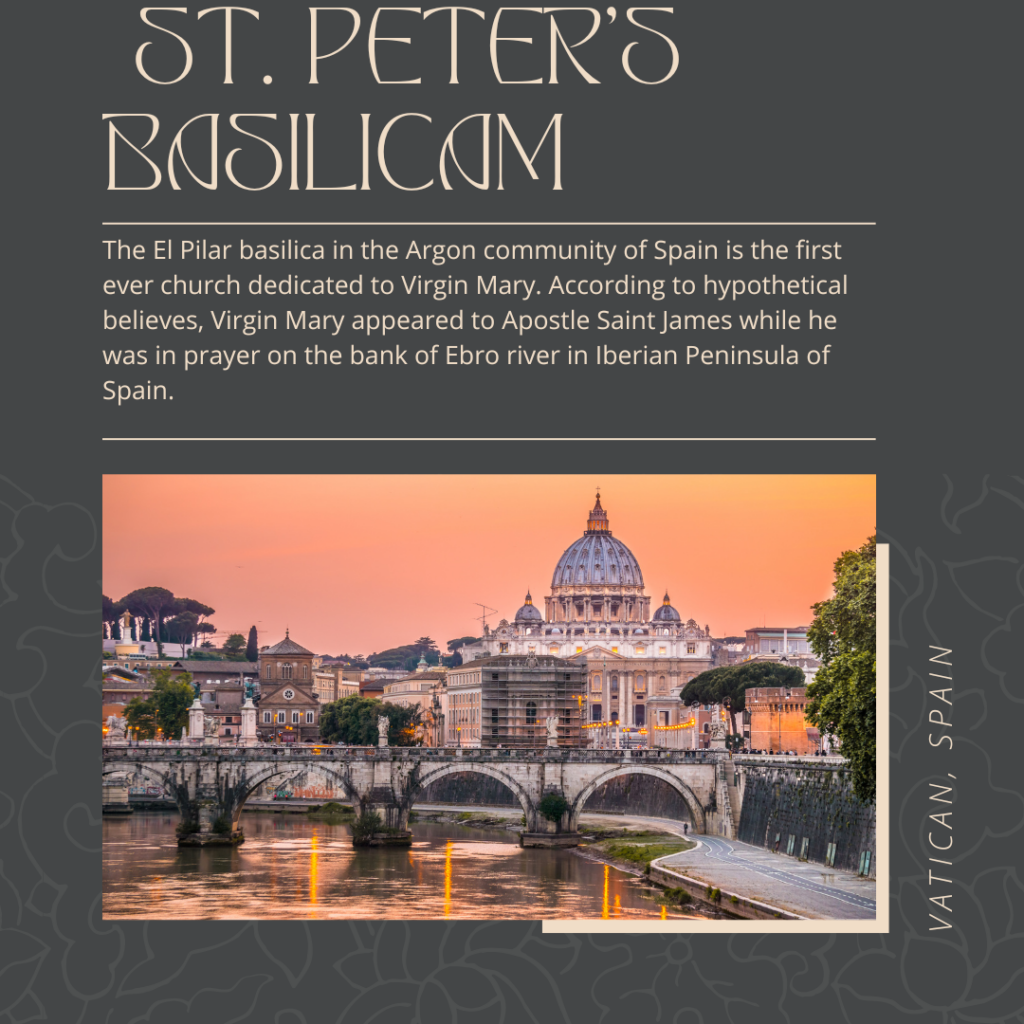
Facts about Churches
Churches and chapels have unique internal features designed to help people worship and open their hearts by confessing to sins they might have committed. Catholic churches are traditionally built on a cross, with its top facing Jerusalem. The east end of the Church is called the sanctuary and contains:
- The altar – During Eucharist, bread and wine are blessed on this table.
- a crucifix – a cross with Jesus on
- a stoup – usually a tiny basin containing holy water, which Catholics dip their hand in to make the sign of the cross to renew their baptism promises
- stained glass windows – often depicting biblical stories or religious teachings
- candles – often lit by Catholics when they are praying
- A confessional – a small enclosed cupboard or cabinet where Catholics can confess their sins to the priest.
A rail separates the sanctuary from where the congregations sit, known as the nave. There are often rows of pews in the nave where the community sits in rows on benches. Around the Church, 14 framed pictures, known as the Stations of the Cross, show the events of Jesus’ crucifixion.
Confucianism
Confucianism is an old Chinese belief system. It focuses on the essence of personal ethics and morality. Its existence as a philosophy or religion is a topic of debate.
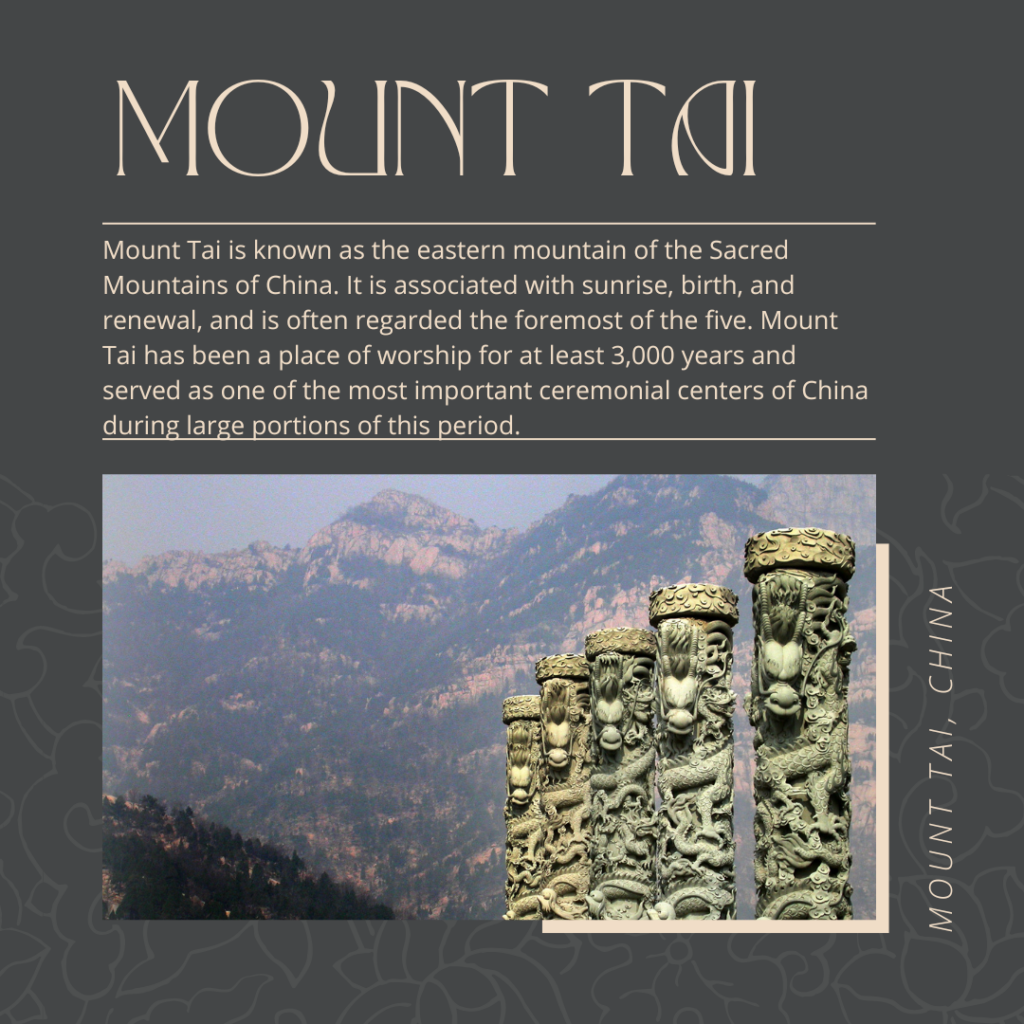
Where is Confucianism’s place of worship?
Some of the holy places of Confucianism are:
- China’s Mount Tai in Shandong Province
- Confucius’ birthplace of Qufu
- The different Confucian temples, academies, and institutes
- The family home.
The Temple of Confucius was built in 478 BC to commemorate and offer sacrifices to Confucius. Some other sites include the Cemetery of Confucius and the Kong Family Mansion in Qufu, Shandong Province of China.
Confucianism believes in ancestor worship and human-centered virtues for living a peaceful life. There are no Confucian gods, and Confucius is worshipped as a spirit rather than a god. However, there are temples of Confucianism, where vital community and civic rituals happen.
No specific place of worship for Confucianism exists. People burn incense as an offering at public temples. However, no religious services in the traditional sense exist.
Traditional homes have altars where incense is burned as an offering each day, and special occasions call for offerings such as food to ancestors. Connection with ancestors dictates much of daily life in Confucianism.
On special occasions, government officials perform rituals for their communities. Many people do not consider Confucianism an actual religion because there are no gods or specific teachings concerning the afterlife.
What is the Holy book of Confucianism?
The sacred texts of Confucianism include Analects, Mencius, Xunzi, Great Learning, and Doctrine of the Mean.
Facts about Confucianism Culture
- The main holidays that Confucianism celebrate are:
- The birthday of Confucius is September 28th.
- They also celebrate the Chinese new year, which is on January 31st.
- Qing ming is another essential holiday that they observe.
- Chongmyo Taeje
- Confucianism is not a religion. However, some have tried to imbue it with rituals and religious qualities.
- It is still a philosophy and system of ethical conduct that has guided China’s society since the fifth century B.C.
- The belief system of Confucianism rests upon the fact that human beings can be fundamentally sound, learn, improve, and perfect themselves through personal and communal endeavors. Primarily through self-cultivation and self-creation.
- Confucian thought focuses on the cultivation of virtue in a morally organized world.
- Four main symbols represent the beliefs and views of Confucianism. These include: “Confucius,” the Chinese character for water, the Chinese character for the scholar, and Yin Yang.
Hinduism
Hinduism is a diverse and rich culture in India, followed by most Indians and Nepalis. According to Hinduism, three Gods rule the world – Brahma: the creator; Vishnu: the preserver and Shiva: the destroyer.
Hindus believe that the universe or Brahman lies within them. Therefore, connecting to Brahman through worship is crucial for them. Hindus use all of their senses to connect to Brahman when they worship. There is a single God within Hinduism, Brahaman, but there are a plethora of deities through which Brahman is expressed.

Where is Hinduism’s place of worship?
A temple in Hindu culture is called a mandir. It is a special place where Hindus worship. Hindu temples are decorated as they represent the idea of a palace, highlighting the idea that God is like a king.
Not all can be kept under one roof due to so many gods in Hinduism. Hence, temples of scriptures of popular gods such as Ganesha and Shiva in most temples.
The dome reaches high in the main shrine room to symbolise the idea that Hindus can reach up to God.
What is the Holy book of Hindus called?
The most followed holy book of Hindu culture is the Bhagwad Geeta, which consists of Lord Krishna’s teachings through the story of Mahabharata.
Features of Hindu Culture
When visiting a Hindu temple, you are expected to follow the given mannerisms:
- Everyone must remove their shoes outside the temple and wash their hands and feet before entering the temple.
- A bell is rung upon entering the shrine to awaken the deities for worshipping.
- When praying, one must kneel before God and joins hands together to offer prayers or greetings.
- One can also chant mantras or recite prayers.
- Next, one may take prasadam (blessed food) provided by people of the temple prepared by the donors or pandits.
- One can carry homemade prasadam to offer God at the temple and receive blessings.
Islam
Islam encompasses ritual worship and daily tasks. Followers of Islam are called Muslims. They are monotheistic and aim to live a life in complete submission to Allah (God in Arabic).
Which is the holy book of Islam?
Quran-e-Sharif is the holy book of Islam. Abu Bakr first compiled the Quran-e-Sharif into a book format.
What is Islam’s place of worship?
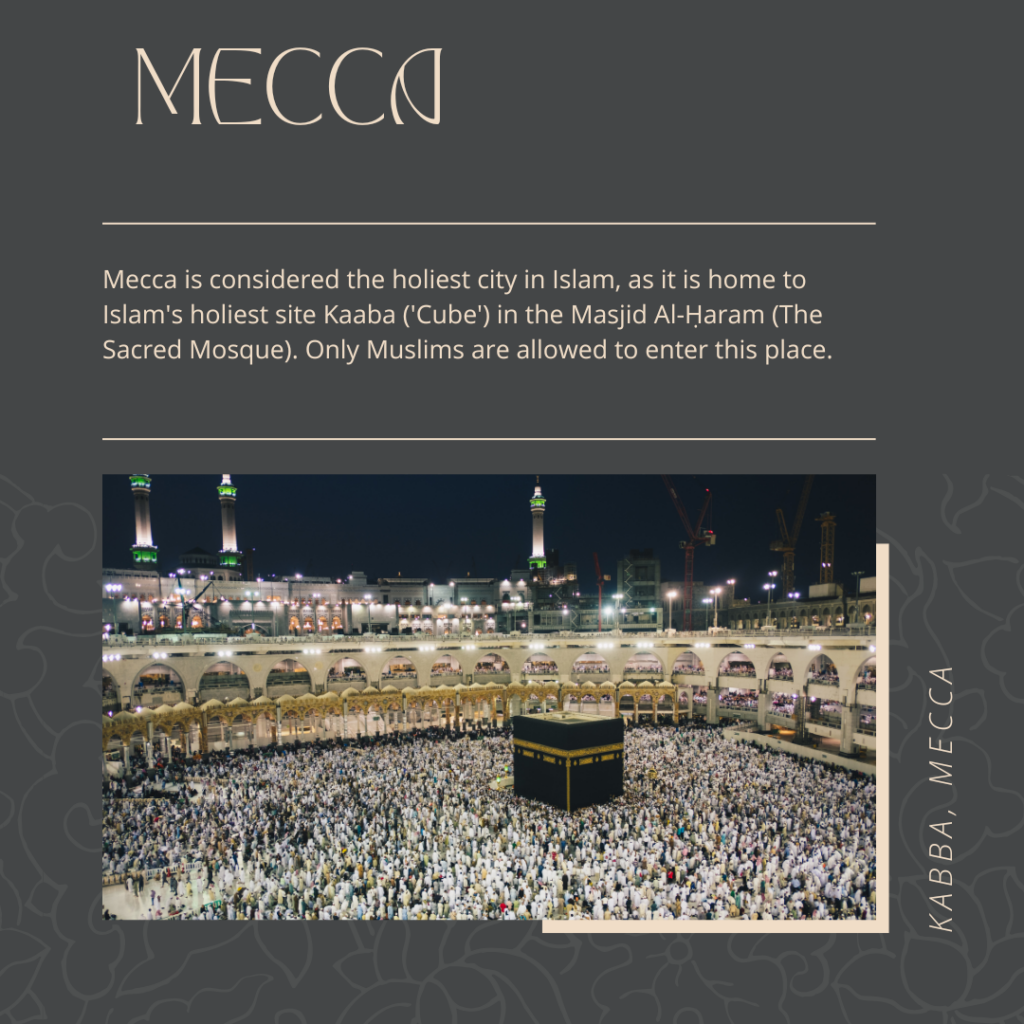
There are many types of Muslim spaces and places of worship of Islam; one of the most famous is the Mosque, usually used by the different orders of Islamic people such as Sunnis, Ahmadiyyas, Shias, Ibadis, Nation of Islam, and Progressive Islam. On the other hand, Aleviler Muslims don’t pray in Mosques; instead participate in different types of Muslim spaces of worship, which include:
- Cemevi or Cem house is pronounced Jem house.
- Jamatkhana: is the Muslim space of prayer for Ismailis
- Jam Khana: is the Muslim space of worship for the Maktabi Ahl I Haqq
- Tekke: is the Muslim place of worship for Bektashis
- Bayt Al Jam’ or the Jam house: is the traditional name of the Muslim place of worship for the Alawites.
Some interesting facts about Muslims and their culture are:
- Muslims pray five times every day, no matter where they are.
- Mosques are very elaborate, large structures or straightforward ones. Some standard features include:
- Sahn is a courtyard encircled by arcades called Riwags. There are water fountains inside the courtyard that symbolizes purity. Before entering the Mosque, worshippers can bathe there.
- The minaret is a structure from which the muezzin (a person) calls Muslims to attend prayer. The minaret looks down on the Sahn.
- Mihrab is an empty arch that points in the direction of Mecca.
- Minbar is where the imam (who leads prayers in a mosque) gives the sermon and leads prayers.
- Zulla is the prayer hall of the Sahn.
- The worship of images of Allah, Muhammad, or Prophets is forbidden in Islam. To honor Allah, they refrain from representing Allah’s images to glorify Allah because none of it can depict God’s true beauty.
- Islamic artists use geometric shapes and patterns on the walls, floors, and holy books. The mosaic work in mosques is impeccable.
- You will find stars and crescents in mosques. They are symbols associated with the fact that Islam has a lunar calendar. In the Quran-e-Sharif-e-Sharif-e-Sharif-e-Sharif, stars are often signs from Allah.
Jainism
Mahavira is the founder of Jainism. Jainism is a non-violent and ancient Indian religion known as Jain dharma. It emerged in India in the 6th century B.C.
The most renowned aspect of Jainism is its precept of non-violence. Non-violence may extend from thoughts, words, and actions in routine life. Jainism also includes forbearing the consumption of animals and dairy products obtained through inhumane treatment of animals. Moreover, abstaining from consuming or harming all living things and eating some vegetables if they are considered living beings (able to sprout) or grown underground is part of their culture. Jainism includes ten life principles that incorporate reincarnation and karma. However, they do not follow the idea that there is a creator – God.
Where is Jainism’s place of worship?
A Jain temple or Derasar is a holy place of worship of Jainism or Jains. Jain architecture is limited to temples and monasteries. Jain religious buildings typically reflect the region’s prevailing style and time in history.

What is the Holy book of Jainism called?
The sacred texts containing the teachings of Lord Mahavira are called the Agamas. These are the scriptures of Svetambara Jainism. The disciples of Mahavira compiled his words into texts or sutras, and memorized them to pass on their wisdom to future generations.
Facts about Jainism Culture
- One must adhere to strict guidelines when visiting a Jain temple or Derasar:
- One must be clean, bathed, and wear fresh or pooja (worship) clothes before entering the temple. While doing this, they shouldn’t eat or go to the washroom. However, drinking water is allowed.
- Remove the footwear outside the temple.
- Leather items are prohibited inside the temple premises.
- Avoid any chewable items in the mouth.
- One should maintain silence inside the temple.
- Wearing traditional clothes is mandatory to perform religious ceremonies within the temple premises.
- Jains believe all life has a soul – from bacteria to plants, animals, and humans and hence, all can reach nirvana.
- Jains do not worship a God or any saint. Instead, they work to attain nirvana as they believe other liberated souls have achieved.
- Some extreme Jains fast to death. They prefer to die rather than cause suffering to the plants they might have to consume to survive.
- Jains make five vows of abstinence:
- Ahimsa (non-violence)
- Satya (truthfulness)
- Asteya (no stealing)
- Aparigraha (non-attachment)
- Brahmacharya (Chaste living)
Judaism
One of the three Abrahamic faiths, Judaism, is the faith worshipped by the Jews. Abrahamic faith includes Christianity, Judaism, and Islam.
Which is the holy book of Judaism?
The Hebrew Bible or Torah is the compilation of the first five books of the Hebrew Bible, namely the books of Genesis, Exodus, Leviticus, Numbers, and Deuteronomy. Judaism follows this compilation of texts.
Place of worship for Judaism
Jews worship in Synagogues. The word “synagogue” comes from the Greek language. The house of prayer is known by its Hebrew name ‘Beit Knesset’ or ‘Yiddish’ name, Shul.
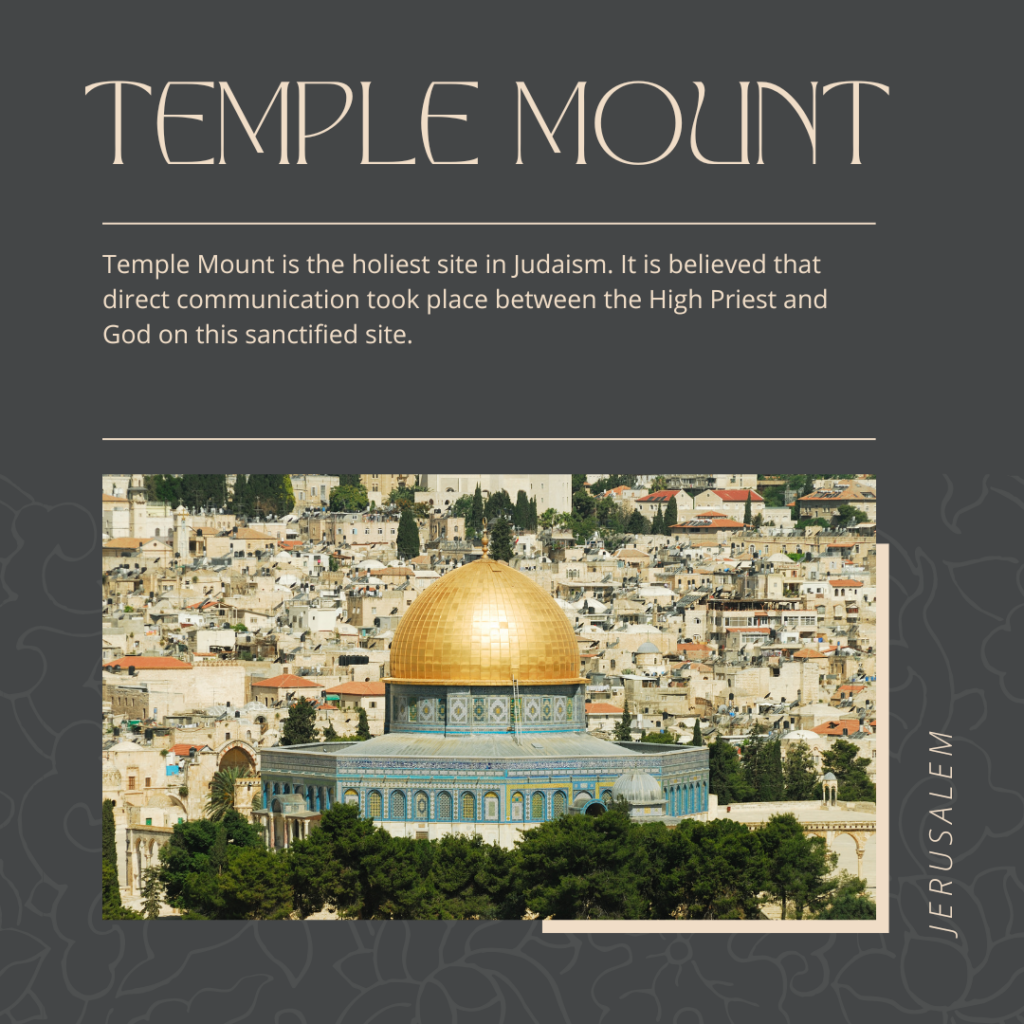
Features of a Synagogue
- Synagogues have been constructed for the sanctuary to face toward Jerusalem, the site of the Holy Temple.
- The front wall of the synagogue has a cabinet known as the Aron Kodesh (Holy Ark). Torah scrolls are the most sacred items in Jewish tradition.
- Toward the center, one finds the bimah, a table on which the Torah is unrolled and read. It is often placed on a platform known as an Almemor.
- Since men and women sit separately in Jewish tradition, synagogue architecture often includes a mechitza, a partition.
Some interesting facts that we have picked for you are:
- Judaism, a rich culture, originated in the Middle East about 3500 years ago.
- Moses founded it. Its history, although, traces back to Abraham.
- Jews firmly believe that only one God with whom they have a covenant exists.
- In exchange for all the good God has done for the Jewish people, they try to keep God’s laws and bring holiness into every aspect of their lives.
- Judaism has a prolific history of religious text, but the Torah’s the central and most crucial sacred document.
- Jewish traditional or oral law, the interpretation of the laws of the Torah, is called Halakhah.
- Spiritual Jewish leaders are called Rabbis.
Sikhism
Sikhs follow the religion and philosophy of Sikhism. This religion originated in the Punjab region of India in the 15th century. The Sikhs call their faith Gurmat, which means “Way of Guru.” The Sikhs are mentally the strongest and the most devoted to human care in India.
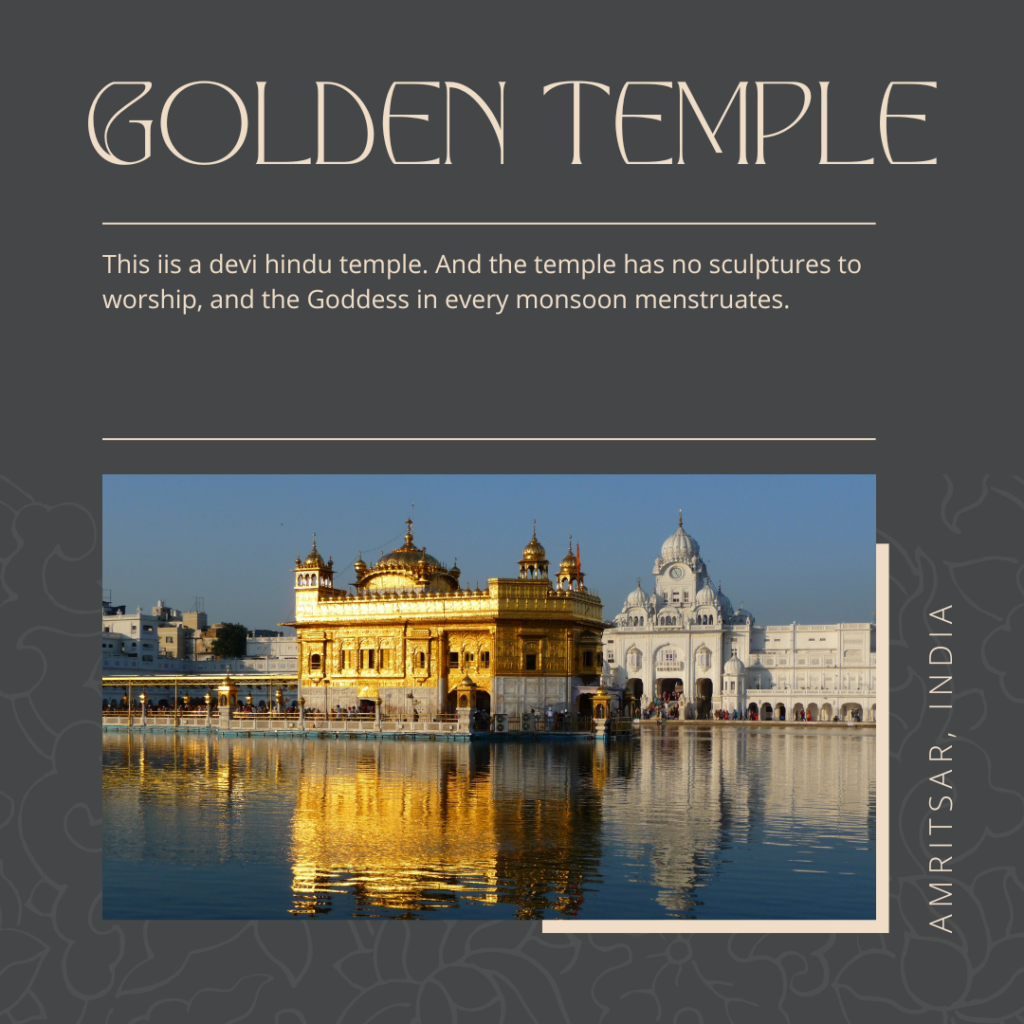
Places of worship in Sikhism
Gurudwara is a place built for Sikhs to gather and offer congregational worship. The Guru Granth Sahib is the central holy religious scripture of Sikhism, which means ‘doorway to the Guru.’ It is believed that the place in which the Guru, embodied in the Guru Granth Sahib, is sacred. For example, the famous Golden Temple.
What is the Holy book of Sikhs called?
Adi Granth, also called Granth or Granth Sahib, is the sacred scripture of Sikhism. It is a collection of approximately 6,000 hymns of the Sikh Gurus (religious leaders) and various early and medieval saints of different religions and castes.
Facts about Sikh Culture
- Sikhs believe that God is known as Ik Onkar or one constant. The texts in the Gurmukhi script say that God has no gender in Sikhism. Also, God is Akaal Purkh – ‘Beyond time and space’ and ‘Nirankar’, which means God has no physical form.
- Guru Gobind Singh created the Khalsa, a spiritual brotherhood and sisterhood devoted to purity of thought and action. Each Sikh baptized as Khalsa has vowed to wear the Five Ks –
- Kesh
- Kangha
- Katchera
- Kara
- Kirpan
- The turban represents respectability and is a sign of nobility.
- Sikhs do not cut their hair but instead coil or knot it on top of the head.
- Sikhism does not believe in good moments, bad moments, good days or bad days, good numbers or wrong numbers. They believe all days of the week and numbers are the same.
- Sikhism refrains from fasting, animal sacrifice, visiting pilgrims, conducting self-torture, or performing similar tasks.
- Sikh women have equal status.
- Sikhism encourages healthy living by consuming natural and straightforward food only.
- Sikhs have “Langars” at every gurudwara that feed everyone who visits.
Shinto Shrine

The Shinto religion is a deeply ingrained part of Japanese culture. Millions, if not billions often visit the country’s countless shrines!
A shrine can be found anywhere in Japan – from small Tokyo buildings hidden behind billboards to vast Anaheim hillsides overlooking Los Angeles city renters–and they all have something unique about them: their kami; the holy beings who live within these structures and help people through times both rough as well calm.
Shrines are places where people go to worship the kami. A shrine may house any type of object that has been given significance by being placed there as a representation or symbol for what they represent – whether this is a natural phenomenon like rainbows and mountains, a human endeavor such as living creatures that live somewhere specific (like dogs), objects associated with an activity someone does regularly like tools used in farming, etc., even abstract concepts can have shrines dedicated too!
Taoism
People in China follow five sanctioned religions: Buddhism, Taoism, Islam, Catholicism, and Protestantism. Of these, Taoism is China’s only indigenous religion and, in recent years, has been experiencing a revival.
Taoism is a primitive Chinese philosophy and religion that teaches its followers to coexist with the universe. Taoism or Daoism has influenced national faith. Lao Tzu was the founder of Taoism in 500 B.C.E. He wrote the Holy book on Taoism called the Tao Te Ching.
Taoists believe in spiritual immortality, where the body’s spirit joins the universe after death. Taoism provides a refuge from society and the trap of material success.
Where is Taoism’s place of worship?
Taoists visit the Chinese Taoist temple called Gong, Guan, or Miao in Chinese. It is the holy hall where Taoists perform various religious ceremonies. It holds Taoist tastes and ideas on construction with traditional Chinese construction methods.
Taoist worshippers often visit temples on critical holy days and regular days. There are three temples: palace-like, ordinary, and simple huts or caves.
What is the Holy book of Taoism called?
The holy book of Taoists, The Tao Te Ching “The Way and Its Power,” is an assortment of poetry and sayings from around the third and fourth centuries B.C.E. Lao Tzu is sometimes considered as the image of the Tao, or God, and has been honored with legendary status.
Features and Facts about Taoism Culture
- Temple decorations reflect the Taoist tenet of a long and prosperous life.
- Popular Chinese characters such as Fu (blessing), Shou (longevity), and Ji (auspicious) are carved on the doors, windows, eaves, and girders of Taoist architecture.
- Cypress and bamboo represent friendship and honor; the tortoise and dragon symbolize long life and ward off any evil.
- Taoism motivates humans to live harmoniously with nature, represented by the stars, sun, moon, and clouds.
- Most Taoist temples are built along a mountainside or in a natural setting.
- Taoism involves scripture, meditation, feng shui, and fortune-telling.
- Taoism disapproves of lying, killing, and stealing. Instead, it encourages charity and kind and helpful behavior.
- The physical practices of Taoism involve martial arts, yoga, meditation, massage, and breathing exercises.
Zoroastrianism
Zoroastrianism is the oldest monotheistic religion that originated in Persia. It contains both the elements of monotheistic and dualistic. Many scholars believe the belief systems of Judaism, Christianity, and Islam influence Zoroastrianism.
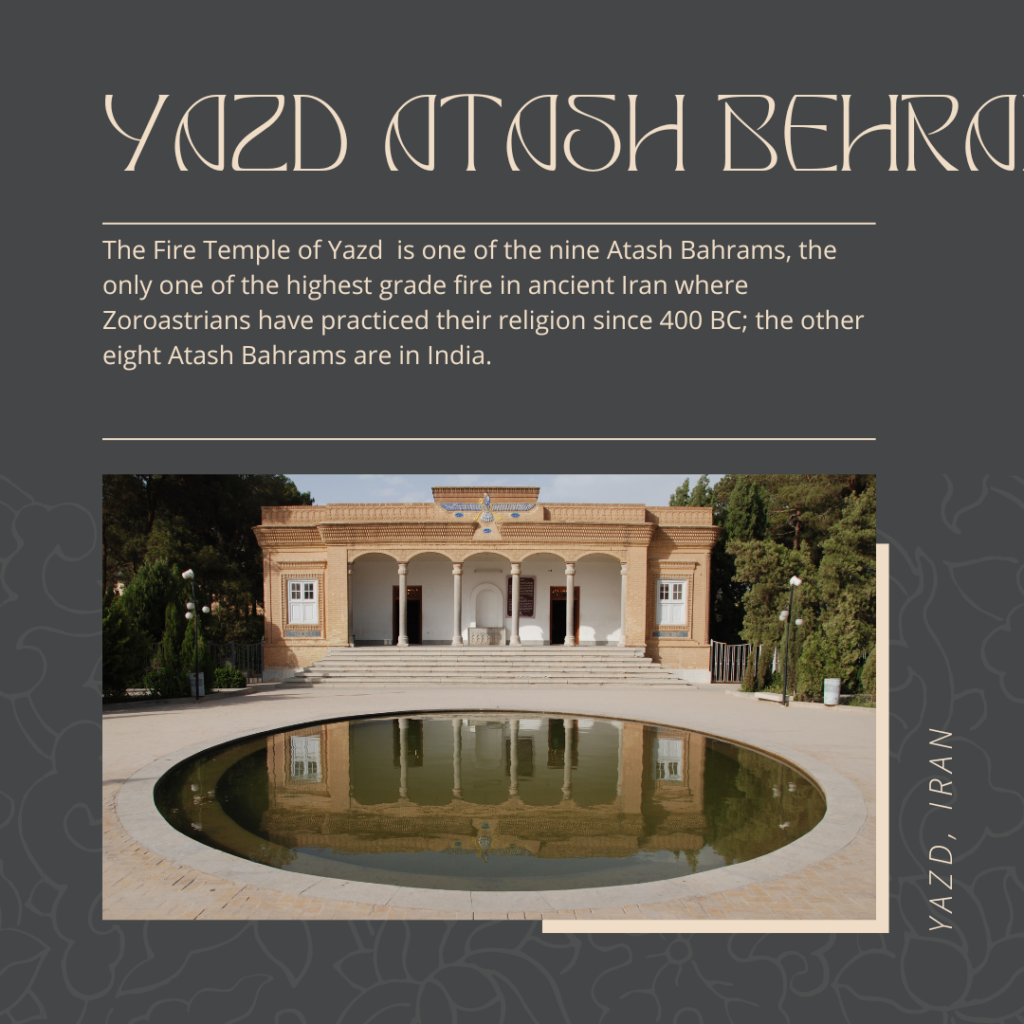
Where is Zoroastrianism’s place of worship?
The Fire Temples are places of worship in the Zoroastrian religion. They were known as Ataskada or the house of fire by the Persians. Today, they are known by their Greek name Pyratheia (fire temple). The belief is that the fire originated from keeping the hearth fire burning throughout the life of the head of a household.
What is the Holy book of Zoroastrianism?
The Avesta consists of the significant beliefs of the Zoroastrian community. This text preaches that the highest God and creator – Ahura Mazdā, is engaged in an ancient battle against Angra Mainyu – the Destructive Spirit. Believers forsee Ahura Mazdā’s eventual victory. All the followers of Angra Mainyu endure all of the eternal human experiences.
Facts about Zoroastrianism Culture
- About 3500 years ago, Prophet Zoroaster (or Zarathustra) founded Zoroastrianism in ancient Iran.
- For approximately 1000 years, Zoroastrianism was one of the most influential religions in the world.
- Zoroastrians believe only one God created the world, Ahura Mazda (Wise Lord).
- Zoroastrians believe that all the five elements of earth are pure, specifically fire, representing God’s wisdom.
The oldest place of worship
Göbekli Tepe is probably the oldest place of worship in the world. Discovered by chance in 1993 by a local Turkish farmer, this archaeological site has intrigued the minds of anthropologists and archaeologists for over two decades. It is, therefore, not surprising that the temple is now listed as a UNESCO World Heritage Site.
Below are the places of worship chart with names.
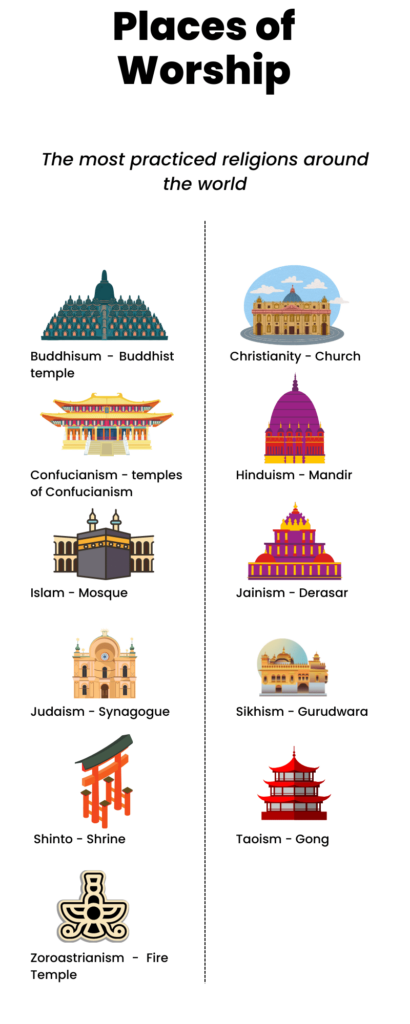
Most common F.A.Q.s:
a. Does God get angry?
God is the supreme creator who loves, forgives and protects his children or devotees from all that is evil. In broader terms, God is the extension of what you make him. If you are afraid of him – he will scare you; if you believe he will show mercy – he will, if you think of him as the epitome of love, care and happiness – he will be.
It resonates with a saying; what you give, you shall receive. God protects those who do good and punishes the ones who commit sins. However, when honestly asked for forgiveness, he will happily forgive you. Prayers and God’s anger is often related to sins. Holy scriptures convey that God’s wrath exists and ensure that it is always under control and righteous.
Also, mentioning the passages in scripture that talk about God’s anger conveys that God gets angry at times. There are many instances given in the Bible. For example, He “displays his wrath every day”. The context of God’s anger verses reveals the reasons behind his anger. It also signfiies that God gets angry at the violation of His character. He is righteous, fair, and holy, and his attributes cannot be compromised.
b. Does God manifest in a form if you pray?
Praying and manifestation are VERY similar & both are EQUALLY as powerful.
The literal definition of manifestation is “obvious to the eye or mind”. In the spiritual world, our description of manifesting is basically “setting intentions & telling the universe what we want to create our desired reality”, & we have to be clear on what we want, right?
So what’s the definition of prayer? It’s a “solid request for help, OR an expression of gratitude addressed to God.”
Prayer is ASKING the universe to manifest what we want. So when we pray or manifest, let God’s manifestation give us what we want – if it is vibrationally aligned. If it doesn’t, what is vibrationally aligned will happen. So when praying, with manifestation, we can tell the universe what we want all day long & one of three things will happen:
You’ll get what you want because it’s in alignment,
You don’t get what you want because it isn’t in alignment (& as mentioned before, it’s not the right time, or
You’ll get what you want because you were so persistent in manifesting & demanding something (or someone) that wasn’t for you.
c. What is God?
God is very much real. The meaning of God is knowing thyself. His characteristics are unique because he is unique. He has no gender – he is neither male nor female. Practically NONE HAS SEEN GOD meaning of God! He has been described in spiritual texts, but never as not born, ever alive, not going to die or end.
Before space and time, he existed, which does not apply to God. He is the creator who formed the big bang or the cosmos. He is independent of any other entity for his survival. No laws of science or human logic apply to Him.
God has no form. He resides in our hearts, our minds, and our thoughts.
d. Why do we worship?
People worship God to give meaning to their lives. Worship is a natural human tendency. If we don’t relate to God worship, we can relate to worshipping many other things. We worship beautiful women, rock stars, and sports heroes; some worship their nation, while others worship money. In some way or the other, everyone has a thing to worship.
Krishna says:
People in the phase of goodness worship the demigods; in the mode of passion, they worship the demons; and those in ignorance worship ghosts and spirits. (Bg 17.4)
After a long time living in the materialist world, you begin to understand that you don’t belong here. As you become older, everything turns into misery, sorrow, and frustration without exception. Even if you are content, old age, disease, and death always get you in the end. But, when you add Krishna to your life and become his devotee – family, society, friends, all your loved ones become insignificant.
Conversely, it is defeatist and irresponsible to surrender oneself to disease, old age, and death. It is defeatist to surrender to nature’s powers. It is irresponsible because the sole prerogative of the human lifeform is for the soul to get out of samsara – the endless cycle of birth and death. To not take advantage of that rare opportunity is irresponsible. The question arises – who would look after the family?
Therefore Krishna says:
Observe and learn the truth by approaching a spiritual master. Inquire from him like a submissive and offer service unto him. The self-realized souls have enough wisdom to impart unto you because they have seen the truth. (Bg. 4.34)
Having obtained fundamental wisdom from a self-realized soul, you will never fall into such an illusion again. You will observe that all living beings are a part of the Supreme with this knowledge. (Bg.4.35)
A faithful man dedicated to transcendental knowledge and who subdues his senses is eligible to achieve such understanding and has earned it; he quickly attains the supreme spiritual peace. (Bg. 4.39)
e. If God exists, why are there calamities, wars, or violence?
Calamities such as the Hurricanes Harvey and Irma, flooding in South Asia and Africa, and Mexico’s massive earthquake have caused immense destruction. Some people think the sins humans may have committed may have angered God and compelled him to make us suffer. Some commented that Hurricane Harvey and Irma were “a spectacular display of God’s immense power,” and the calamity happened so human beings could repent.
Others refused to agree over the reasons for God’s anger, but not necessarily with the assumption that God can be wrathful.
The question of God’s anger is intimately related to the issue of human suffering. Does God protect? YES! God is loving and would never indiscriminate human misery. Some theologians disregard the idea of suffering as divine retribution because such an act would be unworthy of a merciful God. God, in the past, also suffered by being crucified on the cross as Jesus Christ from a Christian perspective.
Instead of dwelling on God’s wrath, we must understand God’s other aspects of kindness and mercy. In times of crisis, God’s compassion and mercy will help reach out to those who need comfort and assistance.



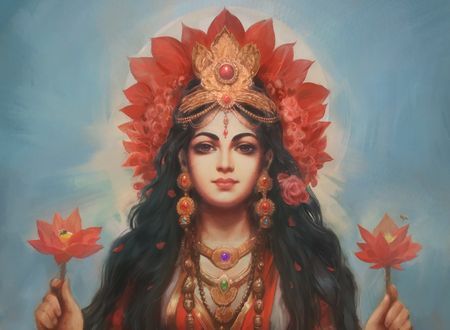

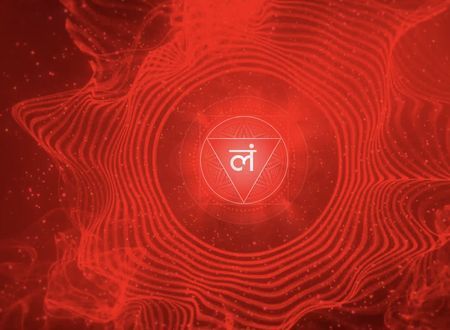



Comments & Discussion
0 COMMENTS
Please login to read members' comments and participate in the discussion.